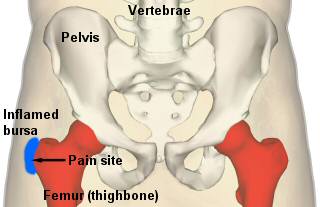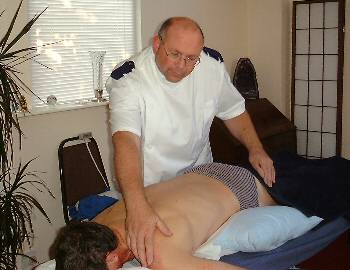The Haven
Healing Centre
The Orchard
Draycott Rd, Cheddar
Somerset

The Haven |

|
| Natural Complementary Therapies - your key to improved health and well-being | |
|
Home About Contact Gift Solutions Articles Treatments Products Page: 1 2 3 4 5 Appointments |
Treatment for Greater Trachanteric Bursitis and Snapping Hip Syndrome using Spinal TouchA Gentle Treatment for Bursitis of the Greater TrochanterSpinal Touch is a reliable and safe treatment for back pain and hip pain caused by injury or inflammation Greater trochanteric pain syndrome (GTPS), also known as trochanteric bursitis, is inflammation of the trochanteric bursa, a part of the hip at it's widest part. The swollen and inflamed bursa area can feel painful, with a dull, throbbing ache, and sometimes can feel like it's on fire. The pain may radiate down the lateral aspect of the thigh toward the knee, but point tenderness over the greater trochanter is the major symptom.
Greater trochanteric pain syndrome (GTPS), also known as trochanteric bursitis, is inflammation of the trochanteric bursa, a part of the hip at it's widest part. The swollen and inflamed bursa area can feel painful, with a dull, throbbing ache, and sometimes can feel like it's on fire. The pain may radiate down the lateral aspect of the thigh toward the knee, but point tenderness over the greater trochanter is the major symptom.This bursa is situated adjacent to the femur, usually on one side or the other, between the insertion of the seating muscles (gluteus medius and gluteus minimus) into the greater trochanter of the femur and the femoral shaft. It has the function, in common with other bursae, of working as a shock absorber and as a lubricant for the movement of the muscles adjacent to it. However, they can on occasion grow spontaneously as the result of impact, abrasion or irritation. Occasionally, the greater trochanter bursa can become inflamed, painful and tender. This condition can be a manifestation of an injury (often resulting from a twisting motion or from overuse), but sometimes arises for no obviously definable cause. The symptoms are pain in the hip region on walking, and tenderness over the upper part of the femur, which may result in the inability to lie in comfort on the affected side. Greater trochanteric pain syndrome can remain incorrectly diagnosed for years, because it shares the same pattern of pain with many other musculoskeletal conditions. Thus people with this condition may be labeled malingerers, or may undergo many ineffective treatments due to misdiagnosis. It may also coexist with low back pain, arthritis, and obesity. How do I get a diagnosis of Trochanteric Bursae pain? The obvious answer is to visit your doctor. They will do several tests that will give you evidence for the condition and hopefully rule out things like fracture or degenerative arthritis. But pain in the area specified is quite a good indicator, and you are the best assessor of the amount of pain you are in. Your doctor may begin by asking you to stand on one leg and then the other, while observing the effect on the position of your hips and taking a postural assessment. Palpating the hip and leg may reveal the location of the pain, while range-of-motion tests will help to identify the source. At best you will be told to rest. Not total wipeout rest, but avoid over excertion of the legs and hips. Cooling the joint (actually the pain point) with a protected ice pack, or ice cubes may help, but only leave in place for a minute or two. The greater trochanter is quite close to the surface and freezing down bone is not the object of the exercise. You are far better off, ice on for 1-2 mins, and off for 5-10 mins, then on for 1-2, off for 5-10 and so on. This is called contrast bathing, which shrinks the bursa and gets blood into the area to heal it. Ice should never be left directly on the skin for any length of time, as this can burn the skin. Another surgery favourite is to take a non-steroidal anti-inflammatory drug which may relieve the pain and reduce the inflammation. If these are ineffective, the definitive treatment is steroid injection into the inflamed area. In extreme cases, where the pain does not improve after physical therapy, cortisone shots, and anti-inflammatory medication, the inflamed bursa can be removed surgically. The procedure is known as a bursectomy. Hopefully it won't get to that. What are some of the causes of Trochanteric Bursitis? Possibly running, fast moving sports, hard contact sports, falls, hip surgery and a variety of preexisting conditions, such as, disease of the gluteal tendons. Other causes of trochanteric bursitis include uneven leg length, iliotibial band syndrome, and weakness of the hip abductor muscles. Not wearing proper fitting shoes can be a major contributor to GTPS. Unfortunately for the ladies, it usually affects more women than men up to a ratio of about 4:1. One of the main problems is the inability to sleep on the affected side and pain during walking normally. It's not unusual for a patient to still be having symptoms 1-3 years after the initial diagnosis, if no steps are taken to rectify the condition. If possible, avoid activities, or take steps to minimize movements that involve climbing stairs, getting in and out of cars, or chairs, jumping or taking large strides. Why do you think Spinal Touch is beneficial for GTPS? Because all too often it is combined with lower back pain and postural distortion. Once this is corrected, it quickly reduces the excessive forces that were a contributing factor in the onset of the greater trochanter inflammation. In addition to your Spinal Touch treatment, I will also show you some simple exercises to perform an Iliotibial band (ITB) stretch and the tensor fascia lata (TFL) stretch, both stood up and lying down, that you can do at home. You may need to work in some ham stretches and quadricep stretches to balance the books as it were. The idea here is to kickstart your healing program with a physical therapy treatment and then have you take over, with my guidance, your recovery. All this is designed to stall the day when you are called in for your jab of corticosteroid. Potentially of course, if you can get a handle on your condition, then you may not need the steroid injection at all. One study from the Netherlands showed that at 12 months the recovery rates of patients with and without the steroid were within 1%.  If you've been suffering for ages and ages, please don't give up hope, it may be an idea for you to give Spinal Touch a try.
If you've been suffering for ages and ages, please don't give up hope, it may be an idea for you to give Spinal Touch a try.What we can achieve with Spinal Touch and Bio-Stress Release is a serious relaxation of the muscles causing the inflammation of your hip bursae, whilst at the same time, correcting any contributing biomechanical abnormalities. This has the effect of reducing the swelling and tenderness of the bursa. As tension is released in the area of the muscles and bones and joints, the effect of all this relaxation and subtle movement is to reduce the pain felt by the patient. Spinal Touch is a very gentle, physical, light touch therapy which is very relaxing to receive and very effective in reducing pain in stressed and damaged muscles, and trapped or damaged nerves, and joints. What about Snapping Hip Syndrome, where does that come in? Snapping hip syndrome (also known as iliopsoas tendinitis, or dancer's hip) is a medical condition characterized by a snapping sensation felt when the hip is flexed and extended. This may be accompanied by an audible snapping or popping noise and pain or discomfort. As with GTPS pain often decreases with rest and diminished activity. It is sometimes caused by inflammation of the iliopsoas bursae, another bursa slightly medial to the greater trochanter bursa that causes GTPS. Movement is accompanied by an audible snapping or popping noise as the tendon at the hip flexor 'twangs' against the bone. The more common lateral extra articular type of snapping hip syndrome occurs when the iliotibial band, tensor fascia lata, or gluteus medius tendon slides back and forth across the greater trochanter. This normal action becomes a snapping hip syndrome when one of these connective tissue bands thickens and catches with motion. The underlying bursa may also become inflamed, causing a painful external snapping hip syndrome. Symptoms usually last months or years without treatment and can be very painful. Our aim with Spinal Touch is similar to treating GTPS, to relax the muscles that are now tight through pain so as to allow the tendon to ride correctly, without jerking, harsh, and therefore painful, movement. Click the link to learn more about Spinal Touch. If you've tried everything else, don't let it go on and on, perhaps it's time to give Spinal Touch a try. Please don't ever think there is nothing more you can do. There is always hope that taking action can make the difference. Have you tried Spinal Touch before? No? Even if everyone around you is advising you to throw tablets at your problem, remember they only MASK the pain, they don't do anything to change your state, nor do they do anything to address the cause. Allow your instinct to lead you toward a gentle physical approach. The relaxation induced postural re-alignment afforded by Spinal Touch Therapy, will help reduce the pain in your body. If this idea resonates with you, and you fancy giving this a try, I invite you to visit The Haven Healing Centre in Cheddar for a private consultation and course of treatment. Click the link for appointments and a treatment price list. I look forward to welcoming you soon. Phil. Please share this page with your friends. Thank you.
Note: DISCLAIMER: This information is not presented by a medical practitioner and is for educational and informational purposes only. The content is not intended to be a substitute for professional medical advice, diagnosis, or treatment. Always seek the advice of your physician or other qualified health provider with any questions you may have regarding a medical condition. Never disregard professional medical advice or delay in seeking it because of something you have read. It's a small investment in yourself, but could be a life-changing experience you will cherish forever. |
| Copyright © Philip Chave 2010- TheHavenHealingCentre.co.uk All rights reserved. Email: privacy |